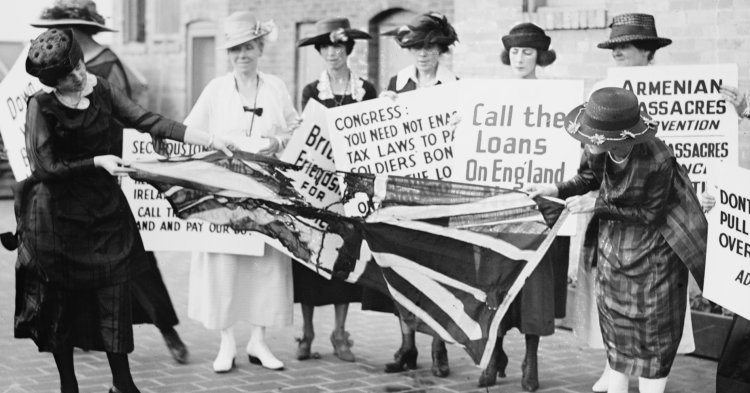In 1912, with the introduction of the third Home Rule Bill, the Irish question reached the forefront of British national politics. Until the outbreak of the First World War, federalism and its accommodation in Ireland was a widely discussed topic. The biggest contribution to the spreading of federalist ideas came from a group of young people interested in the reformation of the whole Empire on federal lines: The Round Table Movement. Said movement managed to exert a great influence on the British establishment, with plans for a federal United Kingdom even reaching Prime Minister Asquith.
In many aspects, the 1912 home rule crisis resembled today’s Brexit one. At that time the different international background, marked by Ireland’s struggle for independence against the declining British Empire and by the upcoming global military confrontation between new and old world powers made the introduction of a federal plan impossible. It was within the EU, however, that Ireland and the UK managed to sustain an equal relationship The partition of Ireland, the solution devised by the British in the aftermath of the First World War, was intended to be provisory but brought – as known – a long period of sectarian violence which only the intervention of powerful external actors, such as the EU, helped to resolve. The final act of this peace process was the signing of the 1998 Good Friday Agreement, which unfortunately did not go so far to completely solve the problem.
In fact, the Belfast Agreement works on the assumption that the UK and Ireland would remain EU members. This is the reason why negotiations between British delegates and the EU representatives has mainly focused on the issue of the Irish border. In fact, once the United Kingdom leaves the EU, the border in Ireland may have its comeback and many of the improvements made by the peace process could be lost. All of this demonstrates that the EU’s role in promoting conflict resolution in Northern Ireland, both through its support for all-island economic activity and its institutional structures, is undeniable. Brexit, on the other hand, has the potential to bring back tensions in the region, potentially tearing apart the United Kingdom itself. A very ‘controversial’ result considering that Brexit was supposed to strengthen Britain’s sovereignty.
While for many the issue of Irish reunification has never gone away, it has acquired increased salience recently. In reality, one of the three pillars on which the Belfast Agreement is built on explicitly includes the possibility of holding a border poll, if it at any time it appears “likely” to the Northern Ireland Secretary that a majority of people in Northern Ireland would vote for a united Ireland. When discussing the creation of a united Ireland, however, it must be borne in mind that no agreement is possible without the full engagement of both Northern Irish communities – and Brexit is a good-enough example how holding a referendum without a plan could be treacherous. Thus, the formulation of a convincing scheme for a post-Brexit united Ireland must be the first step prior to engaging in any debate about a border poll. And once again, federalism could help to resolve this matter.
Federalism is often considered an instrument to accommodate territorially based ethnic, cultural, religious and linguistic differences in divided societies, while preserving the territorial integrity of existing states. Such an innovative form of government aims to achieve political integration based on the combination of “self-rule” and “shared-rule”. According to Wheare, “federalism is the method of dividing powers so that the general and regional governments are each within a sphere co-ordinate and independent”. Despite the failure to introduce a federal system of government in Ireland in the early 20th century, federalism as a solution for the Irish problem made its comeback following Irish and British accession in the EU in 1973. In fact, this period can be considered a turning point for the region, since it helped not only when it came to improving Anglo–Irish relations, but also in developing significant North-South economic and political cooperation.
Without the EU, the Republic of Ireland would have never been able to break its economic dependence on the UK and to raise its status vis-á-vis with its powerful neighbour. After this sense of ‘unequal sovereignty’ was left behind, Ireland accepted disentanglement from the Nationalist rhetoric, which shaped its foreign politics towards Northern Ireland for decades and engaged with the British in a more cooperative way. The European institutions also provided their typical consensual model of decision-making which was adopted by the ‘Six Counties’’ – Northern Ireland was created carving out six out of nine Ulster’s counties – institutions and for setting their relations with Dublin and London. Moreover, cross-border cooperation was encouraged by the conspicuous European regional aids programmes which helped to diminish the sovereignist tension that characterised North-South relations for decades. The whole peace process was therefore actively encouraged by the high degree of openness provided by European institutions. As John Hume reminded in his Nobel Prize speech, “the European Community represented a tangible improvement of the relations between the two parts of Ireland and turned to be ‘healing force’ for the North’s troubles”.
Recently, the growing economic ties between both parts of Ireland have increased discussions on the possibility of major, all-Ireland political developments. All major parties in Northern Ireland have abandoned their scepticism towards the EU and adopted a more positive outlook, even if mostly for pragmatic reasons. Furthermore, Europe found its most enthusiastic supporters in Ireland (both North and South) at least until Brexit. In these new circumstance, the capacity of the weak Northern Irish political system to maintain peace and build economic development could be tested to its limits, with greater potential for marginalisation and sectarian violence, almost forgotten in the last twenty years.
For this reason, the government of the Republic of Ireland has devoted considerable diplomatic efforts with other EU Member States in seeking a formal decision in the event of a future vote for Irish unity. The European Commission itself has conceded that, were a border poll to deliver a majority in favour to of unification, Northern Ireland would be deemed to remain part of the EU without the need for a Treaty agreement or a vote by other Member States, relying on the German reunification precedent.
A new constitution would be needed to accommodate the North population in a united Ireland, where Protestants would represent a tiny minority in a predominantly Catholic country. Moreover, the Belfast assembly would hardly consent to be ‘downgraded’ and to be assimilated in a relatively centralised Republic of Ireland. For this reason, a negotiated deal with Dublin to unite Ireland under a federal-type arrangement would likely be the only solution able to guarantee all existing rights to Northern Irish residents. In a federal state, the protection of the distinctiveness of the Protestant minority could be secured at a constitutional and a local level, and Unionists would form a formidable voting block in a system of government which encourages coalitions. An interesting example of how a federal united Ireland could look like was presented by Sinn Féin in 1971 in Éire Nua (New Ireland). The plan devised the creation of a federation of the four historical provinces of Ireland and the establishment of a multi-level system, administered at the national, provincial, regional and district government levels by competent parliaments. The devised local parliament of Ulster – Dáil Uladh – would give Unionists a unique self-governing body where Catholic and Protestant would be fairly represented. At the same time the cultural and religious diversity of the North will be protected at the central level. The Ulster parliament would be vested with complete legislative and executive powers, its powers anchored in a federal constitution. Despite its innovative aspect Éire Nua was eventually dropped.
Only a few years later, another federal plan was presented by Fine Gael, with much of it included in the 1984 New Ireland Forum Report. The Forum was set up by the government of the Republic in order to discuss the potential political developments that might terminate violence in Northern Ireland and bring to a peaceful reunification of the island and it was open to “all democratic parties which reject violence and which have members elected or appointed to either House of the Oireachtas or the Northern Ireland Assembly”. The final Report devised the creation of a Two-State Federation based on the existing Northern Ireland and Republic of Ireland and gave a great deal of attention to the economic and cultural consequences of the partition. The Forum recognized that decades of partition showed that Unionism and Nationalism had both failed in addressing the identity needs of each community.
According to the Forum “a federal arrangement would, in particular, provide institutions giving Unionists effective power and influence in a new Ireland. The Northern parliament would have powers which could not be removed by an Act of another parliament. Existing civil and religious rights in the North would be unaffected. With a federal framework, Unionists would have parallel British citizenship and could maintain special links with Britain”.
The solution presented in the Report resembled Éire Nua in many ways, but the idea of setting up a two-unit federation was soon dropped because considered an extremely unbalanced arrangement. The disproportion in population between the entities, and the need to safeguard the Unionist section of the community within the smaller unit, would have posed many problems to the authorities and required a lot of additional special measures to secure the success of this arrangement. Even if the Report was eventually rejected both by Unionist parties and the British government, it represented the first attempt made by the political parties of the Republic to seriously engage with Ulster Unionism.
Irish federalism has not arisen in recent years, mainly because the European Union’s high degree of openness has made unification a secondary topic. But Brexit has revealed the limits of national sovereignty, and voices have started advocating for a second Forum which reconsiders federalism for the Irish case. Of course, the question still arises of whether Northern Ireland’s parties will be ever ready to seriously discuss the future of their country. Recent elections in the Six Counties have showed that Sinn Féin and the DUP’s incapacity to overcome their differences convinced many voters to refuse the traditional religious dividing line and give their support to a more moderate and cross-community political centre, something which could represent a fundamental actor in any post-Brexit settlement.


Follow the comments: |
|
